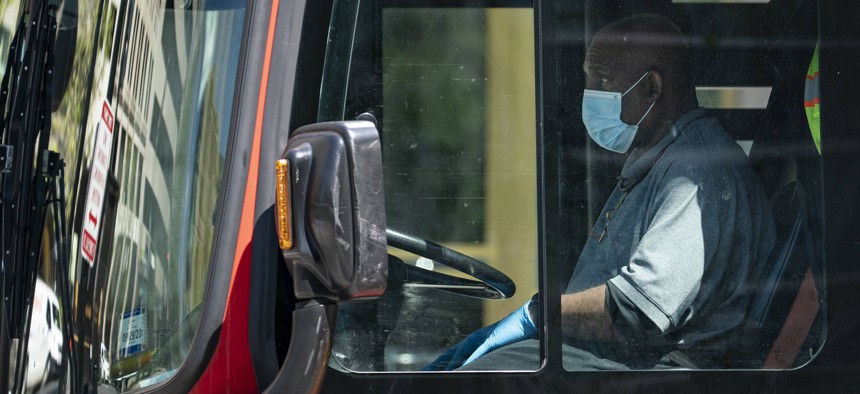Bus Driver Shortage Undercutting Local Transit Systems Nationwide

Drew Angerer via Getty Images
The lack of drivers has forced seven out of 10 agencies to cut or delay service, according to a new report.
The trouble transit agencies of all sizes are having hiring and keeping bus drivers is hurting their ability to bounce back from the many pandemic-related problems they face, an advocacy group claimed in a new report.
A lack of bus drivers has forced agencies to cut service or put off system redesigns that could attract the riders agencies need to shore up their finances and reinvigorate their local economies. More than seven out of 10 transit agencies reported in February they had to cut or delay service because they were short of workers.
If the problem persists, it could undercut those agencies’ ability to deploy cleaner buses or other improvements that could come from the new federal infrastructure law, warned TransitCenter in its report.
“An increased rate of retirement coupled with struggles to recruit and retain new operators have played a key role in creating operator shortfalls. Even in the absence of a pandemic, transit agencies would be challenged by a lack of workers,” the group wrote.
Transit shares many of the difficulties attracting workers that other government agencies do. Its workers skew older, making it difficult to replace all of the baby boomers who retired in recent years.
Recruiting new drivers is difficult, because potential applicants no longer see it as a reliable middle-class job, because salaries have not kept up with the cost of living – particularly for housing, the group noted.
“Some of the most transit-rich American cities are amongst the most expensive to live in, which means that many operators cannot afford to live in the cities they serve,” the group wrote. For example, only 42% of bus drivers for the San Francisco Municipal Transportation Agency lived in the city in 2019, the report noted.
Many agencies require drivers to work for several years before they can reach their top pay bands, and drivers say there are fewer opportunities than in the past to get promoted into other jobs – like a manager or route planner – outside of the driver’s seat.
Chris Van Eyken, the author of the report, said the bus driver job has “deteriorated” in recent years, too.
“Some of that is just that the job hasn’t kept up with what folks expect in the workplace these days, but some of it is also just that the job has become less safe,” he said. Drivers complain that riders try to start fights with them or spit on them.
Meanwhile, staffing shortages contribute to the stress, too, he said. With fewer drivers available, those who remain have less flexibility with their schedules. On the job, they have less time between the routes they drive, and the facilities they have available to them are often inadequate.
“Facilities, like break rooms, are sparse and fail to meet the needs of people in a job that is sedentary, stressful and time intensive. Break rooms are poorly furnished, lack comfortable seating, healthy food options, updated bathroom and washroom facilities, and even natural light in some cases,” Van Eyken wrote in the report.
TransitCenter offered several ideas for agencies to help recruit and retain more bus drivers, including:
- Better promoting the benefits of being a bus driver, beyond just pay. For example, many could show their health insurance packages are more generous than those offered by private employers. They could play up the role drivers play in connecting with community members and with each other. Some applicants might be interested in the environmental benefits they are providing by reducing vehicle trips, Van Eyken told Route Fifty.
- Improving the hiring process by making the job openings accessible and easy to find on the web. Agencies should be responsive and “not let applications sit unacknowledged for weeks or months,” the report said. Many applicants could also use help getting their commercial driver’s licenses, it added.
- Offering better facilities. Agencies could do this by, for example, starting and ending routes at transit centers that offer those amenities. Or the agencies can pursue money from the federal infrastructure law to upgrade their buildings, the TransitCenter suggested.
- Making buses safer for drivers. In Europe, operators often have better partitions to separate them from customers and often have a separate door to allow them to get in and out without going through passengers, Van Eyken noted. The report also urged agencies to develop systems so that drivers no longer have to collect fares. “As U.S. transit agencies procure new buses—with the transition to all electric fleets happening across the country—there is an opportunity to also reconsider the internal design and provide more protection to bus drivers,” Van Eyken wrote in the report.
The group said state governments could improve the situation by better funding transit systems, speeding up the process of getting commercial driver’s licenses and expanding the potential workforce to people with criminal records or with prior drug and alcohol addictions.
For more information from the report click here.
Daniel C. Vock is a senior reporter for Route Fifty based in Washington, D.C.
NEXT STORY: Cities and Towns Embrace 'Summer Fridays' for Their Workers






